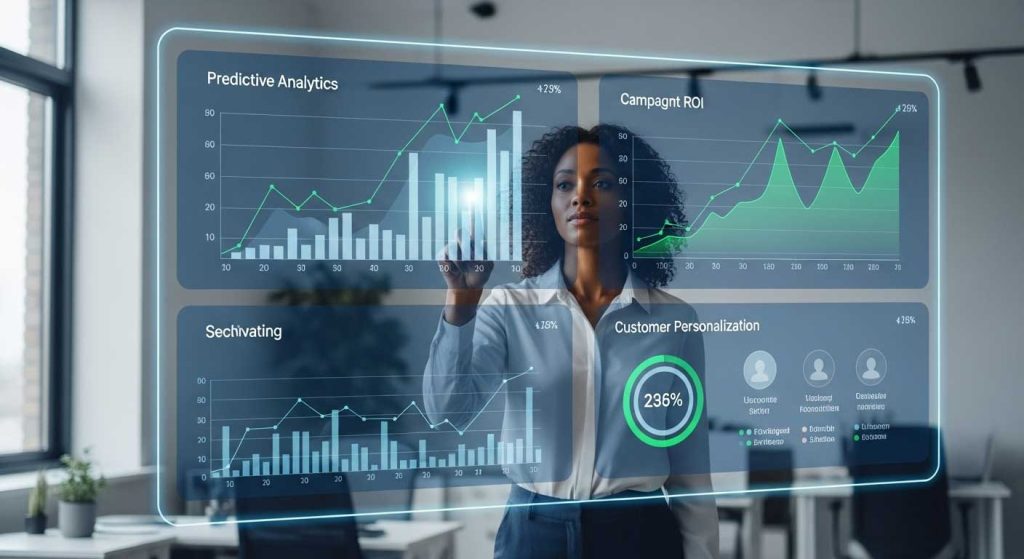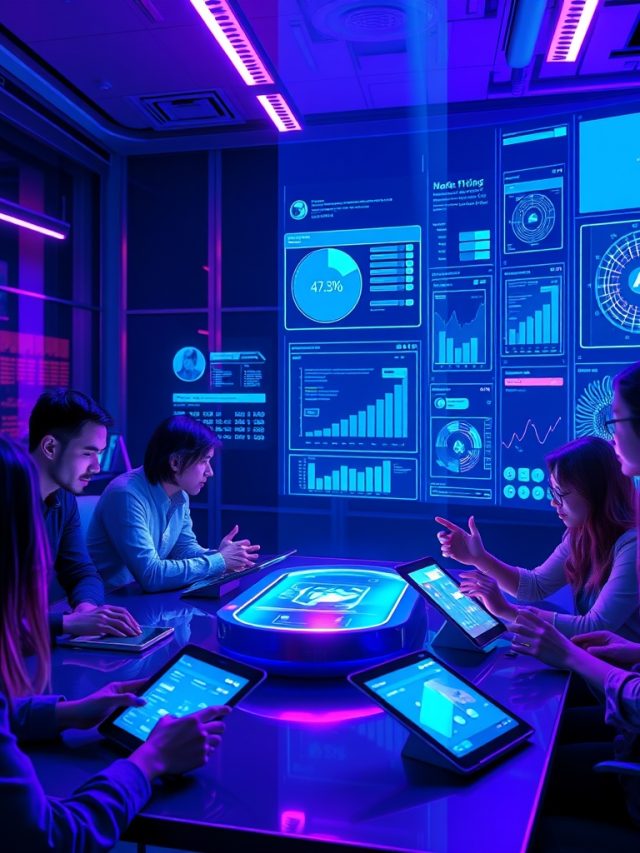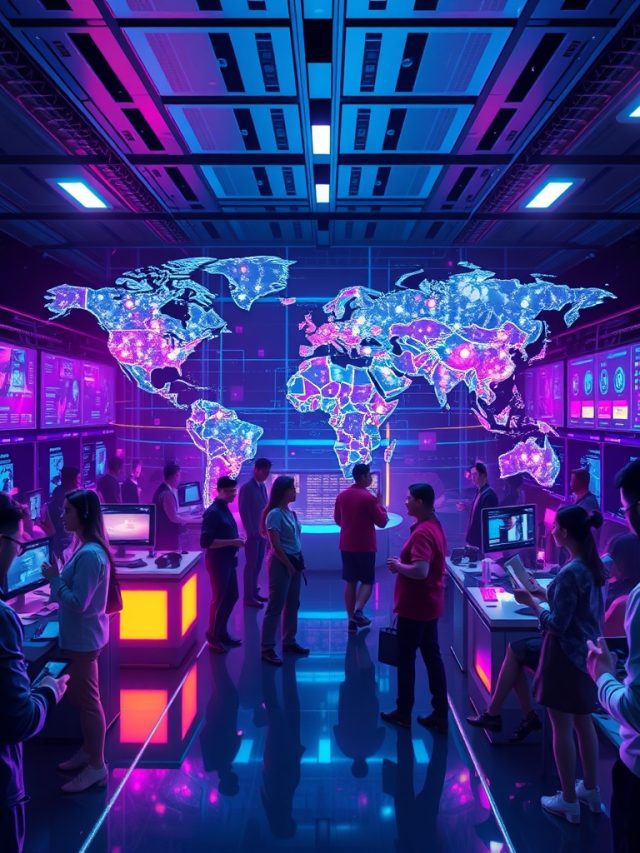Picture a classic marketing war room from just a decade ago: overflowing whiteboards, complex spreadsheets, and a team of smart people making strategic decisions based on last quarter’s data and a healthy dose of “gut feeling.” Now, contrast that with the modern reality of AI marketing, where decisions are made in microseconds, campaigns are optimized in real time, and customer experiences are personalized for an audience of one.
Table of Contents
The modern customer journey is a chaotic and intricate web of digital touchpoints, generating a tsunami of data every second. For human marketers, trying to manually analyze this information to make the right call is not just difficult; it’s impossible. This is where AI in marketing decision making moves from a “nice-to-have” novelty to an essential co-pilot for navigating the complexities of the digital age. AI doesn’t just analyze the past; it helps predict the future.

This article will provide a deep dive into how does AI help marketing professionals make smarter, faster, and ultimately more profitable decisions. We will explore the core technologies that power this revolution, showcase compelling real-world examples of AI in marketing, and discuss the tools, benefits, and critical ethical considerations that every business in the USA needs to understand to stay competitive.

What is AI Marketing? Moving Beyond the Buzzword
Before we can appreciate its impact on decision-making, it’s crucial to understand what AI marketing actually is. It’s more than just a futuristic buzzword; it’s a practical application of powerful technologies that are reshaping the marketing landscape from the ground up.
The Engine Behind Smart Decisions
At its core, AI marketing is the use of artificial intelligence technologies—primarily Machine Learning and Natural Language Processing (NLP)—to analyze massive datasets (“big data”) and automate marketing tasks and decisions. It works by sifting through terabytes of data from all your business’s touchpoints—your website analytics, CRM, social media channels, and ad platforms—to identify hidden patterns in AI and consumer behavior.
The Critical Shift: From Reactive to Predictive
The most fundamental way how does AI help marketing is by changing the very nature of analytics.

- Traditional Analytics is Reactive: It looks backward to describe what has already happened (e.g., “Our click-through rate was 2% last month”). It’s descriptive and diagnostic.
- AI-Driven Analytics is Proactive: It looks forward to forecast what is likely to happen and recommend the best course of action. It’s predictive (“Which customers are most likely to buy next month?”) and prescriptive (“What specific offer should we send them to maximize the chance of conversion?”).
This shift from guesswork to data-backed foresight is not just theoretical. A landmark study by McKinsey found that firms that effectively leverage this kind of data-driven creativity and analytics see their revenues increase by a significant 5-15%. This is the power of making consistently smarter, data-driven marketing decisions.
The Power of Prediction: How AI Transforms Strategic Decisions
The true superpower of AI marketing lies in its ability to predict the future. By analyzing past behavior, AI models can forecast future outcomes with a remarkable degree of accuracy, allowing marketers to move from reacting to the market to actively shaping it.
Using Predictive Analytics in Marketing to See the Future
Predictive analytics in marketing is the process of using historical data, statistical algorithms, and machine learning to forecast what will happen next. This capability transforms every aspect of strategic planning.
Predicting Consumer Behavior
AI can analyze a customer’s digital footprint to predict their next move. It can identify which leads are most likely to convert, which existing customers are at risk of churning, and what products or services a user will be interested in next, often before the user knows it themselves.
Forecasting Market Trends
By analyzing real-time search trends, social media conversations, and online articles, AI can detect emerging trends and shifts in consumer sentiment. This gives marketers an early warning system, allowing them to pivot their messaging or product strategy to capitalize on a new trend before their competitors do.
Predicting Customer Lifetime Value (CLV)
AI models can analyze a customer’s purchase history, engagement level, and demographic profile to accurately forecast their total value to the business over the entire course of the relationship. This allows marketers to make smarter decisions about how much to invest in acquiring different types of customers.
Real-World Examples of AI in Marketing Decision-Making
This isn’t just theory. The world’s biggest brands are already using AI in marketing decision making to create powerful competitive advantages.
Instance 1: Netflix’s Recommendation Engine
When you log into Netflix, the AI doesn’t just show you a random list of movies. It makes a multi-million dollar marketing decision in a split second. A staggering 80% of the content watched on the platform is driven by its AI-powered recommendation engine, which predicts what you will most likely enjoy based on your viewing history.
Instance 2: Amazon’s Predictive Shipping
Amazon takes predictive analytics in marketing to the next level. Its AI analyzes regional buying patterns and demand forecasts to pre-emptively ship products to local warehouses before customers even place an order. This is the ultimate example of making proactive, data-driven marketing decisions to improve the customer experience.

Instance 3: Starbucks’ “Deep Brew” Platform
Starbucks uses its “Deep Brew” AI platform to power its wildly successful mobile app. The AI analyzes each customer’s purchase history and preferences to decide which personalized offer or promotion to send them. This micro-decision, made millions of time a day, is a key driver of customer loyalty and repeat business.
Hyper-Personalization at Scale: AI’s Impact on the Customer Experience
The holy grail of marketing has always been to deliver the right message to the right person at the right time. For decades, this was an impossible dream. With AI marketing, it’s becoming a daily reality through the power of hyper-personalization.
From Mass Marketing to Markets of One
The key to cutting through the overwhelming noise of the digital world is relevance. AI for marketing personalization makes this relevance possible at a massive scale. By analyzing each user’s unique data profile, AI can tailor every aspect of the customer experience.
Dynamic Content Optimization (DCO)
This is a powerful technique where AI can change the content of a webpage, an ad, or an email for every single visitor in real time. For example, an e-commerce site can use AI to show a visitor from a cold-weather state images of winter coats, while simultaneously showing a visitor from a warm-weather state images of swimwear.
Enhancing the Entire Customer Journey
AI for marketing personalization impacts every stage of the customer journey.
- AI-Powered Chatbots: Provide instant, 24/7 customer support and can guide users through a purchase decision by answering their specific questions.
- Recommendation Engines: As seen with Netflix and Amazon, these tools are masters of cross-selling and up-selling by predicting what else a customer will like. This is a core function of how does AI help marketing drive revenue.
- AI-Driven Audience Segmentation: Traditional marketing relies on broad demographic segments (e.g., “males, 18-34”). AI creates hyper-specific, behavioral micro-segments (e.g., “night-owl shoppers who browse on their phone and are motivated by free shipping offers”). This allows for far more precise and effective ad targeting.

The Practical Benefits of AI in Marketing Decision-Making
| Decision-Making Area | Traditional Marketing Approach (Human-Led) | AI-Powered Marketing Approach | Tangible Business Outcome |
| Campaign Targeting | Based on broad demographic personas and historical data (e.g., “women, 25-40”). Slow to adapt. | Dynamic Behavioral Segmentation: Creates thousands of micro-audiences based on real-time browsing, purchasing, and engagement data. | Higher Conversion Rates: Reaching the right person with the right message, dramatically improving ad relevance. |
| Budget Allocation | Manual allocation based on last month’s channel performance. Decisions are made weekly or monthly. | Automated, Real-Time Budget Optimization: AI algorithms shift ad spend between channels (Google, Meta, etc.) hourly to maximize performance. | Increased ROAS: Reduces wasted spend on underperforming channels, maximizing the ROI of AI marketing. |
| A/B Testing | Manually create and test 2-3 versions of an ad over several weeks. Limited by human capacity. | Automated Multivariate Testing: AI generates and tests hundreds of creative variations (headlines, images, CTAs) simultaneously and in real time. | Accelerated Learning & Optimization: Find the winning ad combination in days, not months, leading to faster AI campaign optimization. |
| Customer Retention | Reacts to churn after it happens. Relies on broad “win-back” campaigns. | Predictive Churn Analysis: AI identifies at-risk customers before they leave and can trigger automated, personalized retention offers. | Lower Customer Churn: Proactively saving valuable customers, which is cheaper than acquiring new ones. |
| Content Strategy | Based on keyword research tools and competitor analysis. Often a slow, manual process. | AI-Driven Content Intelligence: AI analyzes top-performing content, identifies “content gaps,” and suggests topics with the highest probability of ranking and engaging users. | Improved SEO & Engagement: Creating content that the audience (and search engines) actually wants, faster. |

AI-Powered Campaign Optimization and ROI
Ultimately, every marketing decision is judged by its return on investment. This is where AI marketing truly shines, by using data to ensure that every dollar of the marketing budget is spent as effectively as possible.
Maximizing Every Marketing Dollar
AI campaign optimization is a continuous, automated process.
- Real-time Bidding (RTB): In the world of programmatic advertising, AI algorithms make billions of decisions every day, analyzing user data in a fraction of a second to decide how much to bid for an ad space for a specific user.
- Multi-Touch Attribution: In the past, it was difficult to know which marketing channel deserved credit for a sale. AI can analyze the entire customer journey and assign a value to each touchpoint (a blog post, a social ad, an email), giving marketers a true understanding of what’s working.
The Bottom Line: The ROI of AI Marketing
The data is clear: when implemented correctly, AI marketing delivers a powerful return.
- Numerous industry reports suggest that AI marketing can improve overall marketing ROI by over 30%.
- This increase in ROI of AI marketing comes from several key areas:
- Reduced Wasted Ad Spend: By automatically identifying and eliminating low-performing audiences and ad placements.
- Optimized Bidding: Ensuring you never overpay for an ad impression.
- Increased Ad Relevance: Driving higher click-through and conversion rates through deep personalization.
Key AI Marketing Tools for Optimization
You don’t need to build a custom AI from scratch to reap these benefits. Marketers in the USA are already using powerful AI marketing tools every day.
- Built-in Platform AI: Platforms like Google Ads (with its Smart Bidding features) and Meta Ads (with its dynamic creative optimization) have powerful AI built directly into them.
- CRM with AI: Customer Relationship Management platforms like Salesforce Einstein embed AI in marketing decision making by providing predictive lead scoring (identifying which leads are most likely to buy) and recommending the “next best action” for sales teams.
- AI for Small Business Marketing: The rise of affordable SaaS tools has leveled the playing field. Tools like Jasper for content creation or AdCreative.ai for generating ad visuals make powerful AI marketing tools accessible to everyone.
The Human Element: Ethics and the Future of Marketing
The power of AI marketing also comes with significant responsibilities. As we allow algorithms to make more decisions, it’s critical to address the ethical implications and understand how the role of the human marketer will evolve.
The Critical Conversation around Ethics in AI Marketing
- Algorithmic Bias: This is a major risk. An AI is only as unbiased as the data it’s trained on. If historical data contains human biases, the AI will learn and amplify them. A chilling example is the concept of “digital redlining,” where an AI could learn to exclude certain demographics from seeing ads for housing or financial products based on biased historical data.
- Data Privacy: The use of personal data for AI for marketing personalization must be done in compliance with regulations like Europe’s GDPR and the California Consumer Privacy Act (CCPA). Responsible AI marketing requires a “privacy by design” approach.
- The “Black Box” Problem: Many advanced AI models are a “black box,” meaning it’s not always clear why they made a particular decision. This lack of transparency is a major challenge for accountability.

The Future of AI in Marketing: Man vs. Machine?
Will AI replace human marketers? The overwhelming consensus is no. The future of AI in marketing is one of human-AI collaboration. AI will handle the complex data analysis and repetitive optimization tasks, freeing up human marketers to focus on the things that machines can’t do.
The Skills of the Future
In an AI-dominated world, the most valuable marketing skills will be uniquely human:

- Strategic Thinking: Setting the overall vision, goals, and ethical guardrails for the AI to operate within.
- Creativity and Storytelling: Crafting the emotional, compelling brand narratives that connect with people on a human level.
- Data Interpretation and Literacy: Understanding the AI’s output, asking critical questions, and knowing its limitations.
- Ethical Judgment: Ensuring that the power of AI marketing is being used responsibly and fairly.
- Prompt Engineering: The emerging skill of being able to effectively communicate with and guide AI systems to get the desired results.
Conclusion
The era of making marketing decisions based on intuition and historical data is over. How does AI help marketing? It fundamentally transforms the decision-making process from being reactive and guesswork-based to being proactive, predictive, and precisely data-validated.
The real-world examples of AI in marketing from brands like Netflix and Amazon are not futuristic exceptions; they are the new standard. However, the true power of AI in marketing decision making is not about replacing the marketer. It’s about empowering them. It’s about providing them with a powerful analytical partner that can see patterns and predict outcomes with superhuman ability.

By embracing this technology, understanding its capabilities, and being mindful of its limitations, businesses can make better, faster, and more customer-centric decisions. The journey starts by moving beyond the myths and focusing on a single, strategic question: what is one decision-making process in my marketing that could be made smarter with the power of AI?
Frequently Asked Questions (FAQs)
1. Will AI completely replace human marketers?
No. AI will automate analytical and repetitive tasks, but it cannot replace human skills like creativity, strategic thinking, brand building, storytelling, and ethical judgment. The future is a partnership where AI provides the data, and humans provide the wisdom.
2. What is the single biggest benefit of using AI for a small business?
The biggest benefit is access. AI for small business marketing provides affordable access to sophisticated analytics, personalization, and automation tools that were previously only available to large enterprises, allowing them to compete more effectively.
3. How accurate is AI at predicting consumer behavior?
Accuracy can be very high, often exceeding 80-90% for specific tasks like predicting which customers will respond to an offer. However, its accuracy depends entirely on the quality and quantity of the data it’s trained on.
4. What are the biggest ethical risks of using AI in marketing?
The biggest risks are algorithmic bias (unintentionally discriminating against certain groups), lack of transparency (the “black box” problem), and data privacy violations if user data is not handled in compliance with laws like GDPR and CCPA.
5. What’s the difference between marketing automation and AI marketing?
Traditional marketing automation operates on simple “if-then” rules set by a human (e.g., “IF a user downloads an ebook, THEN send them this email”). AI marketing is adaptive; it learns from data and makes its own decisions (e.g., “This user is showing behaviors that indicate they are likely to churn, so I will send them a personalized re-engagement offer”).
6. Do I need to be a data scientist to use AI marketing tools?
No. Modern AI marketing tools are designed with user-friendly interfaces that do not require any coding. The key skill is shifting from technical expertise to strategic thinking and the ability to ask the AI the right questions (prompt engineering).
7. How does AI analyze customer sentiment?
AI uses Natural Language Processing (NLP) to analyze text from customer reviews, social media comments, and surveys. It can identify the emotional tone (positive, negative, neutral) and specific topics of conversation, giving brands a real-time understanding of public perception.
8. Can AI help me decide how much to spend on my marketing budget?
Yes. AI can help by running simulations to forecast the likely ROI of different budget scenarios. It can also perform real-time budget allocation, automatically shifting spend to the channels and campaigns that are delivering the best results.
9. What is a real-world example of AI improving ROAS?
Google Ads’ Smart Bidding is a perfect example. The AI automatically analyzes dozens of signals in real time (like the user’s device, location, and time of day) to adjust the bid for each individual ad auction, aiming to achieve the highest possible conversion value for the set budget, thus improving Return on Ad Spend (ROAS).
10. How can I start learning about AI for my marketing career?
Start by experimenting with the AI features already built into the platforms you use every day (like Google Ads, Meta Ads, and your email marketing software). Take online courses on the fundamentals of AI in marketing, and focus on developing your data literacy and strategic thinking skills.









